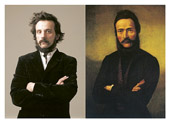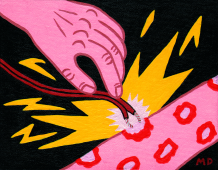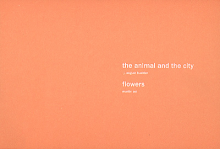In the 19th century, Central Europe experienced a wave of National Revivals, which were heavily influenced by national mythology. Only now can we differentiate between the two – for a long time, national mythology and national history were revered as one and the same thing. It was not only unpopular, but also unacceptable, to question this presumption. As a result, national identity was part truth, part historical manipulation.
Since then, we have radically revised our history, and would like to believe that the present is more objective than the past. However, new mythologies replace old ones, and history must be constantly scrutinized and reinterpreted. In his works, artist Svätopluk Mikyta puts history to the test.
Mikyta (1973) is a Slovak artist with a strong Central European identity. An assistant teacher at the Academy of Fine Arts and Design in Bratislava – where he studied printmaking – Mikyta been to Stuttgart, Bern and Berlin on various scholarships. In 2003, he was a finalist for the Oskár Čepan Prize, which he won in 2008. He subsequently spent a residency at the ISCP in New York While he currently works in Bratislava, he has spent time living in Germany, and he often travels between Vienna, Krakow and Berlin for his work.
Mikyta is a member of the post-revolution generation, a generation that has had the chance to travel and study abroad in the West. His work comes out of these circumstances – it is the artistic testimony of a generation. Mykita is a tireless artist, creating vast thematic cycles and archives of his works. His work largely centers on two major themes. First, Mikyta has a strong interest in Slovak history and identity. Secondly, he explores the fate of the individual – including himself – within the context of the time. He explores these themes using “inconspicuous” media – drawings, ceramics and installations – thus creating a subtle personal history.
Despite his nomadic lifestyle, Mikyta’s work reflects his strong attachment to Slovakia. Slovak mythology is full of symbols – Slovak shepherds, Jánošík (the famous Slovak national folk hero), beautiful mountainous nature, hard-working people, young lads and maidens in national costume, herds of sheep and wooden huts decorated with traditional folk ornaments. These symbols represent the goodness of the Slovak people. They illuminate national history, invoke patriotic pride, and justify a meaningful national existence.
Still, mythology often reflects the historical successes or losses of a nation. With an agrarian past and without much heroic history, affected by a millennium of political control from the outside, Slovaks easily succumb to this positive myth creation. In the communist period, socialist realism further emphasized the iconography of folk heroes. The popularity of these Slovak symbols is undeniable – they are still part of everyday life, even 150 years after the National Revival.1
In his work, Svätopluk Mikyta reevaluates present-day Slovak mythology in a process that utilizes irony as well as nostalgia. He does not work iconoclastically with these symbols – but rather, he gives them new meanings. One of Mikyta’s symbolic subjects is the potato – an artifact linked to the life of the farmer and to socialist agriculture. Mykita’s potatoes are usually sprouting, and their roots create various entanglements – the Slovak double cross, for example. Thus the potato, originally from South America, becomes a Slovak Christian potato. Mikyta emphasizes his sarcasm by naming his works The Right Variety or The Year of the Potato2 – names that could be found on plaques in an agricultural museum.
However, at the same time, potatoes are very much a part of Slovak culture and history – in some parts of Slovakia, they fed many people during periods of famine. This celebration of the potato is part of a reevaluation of history. Mikyta adds: “the shape of the potato is also important – instead of it being a regular sphere, it is an irregular sprout, which is a rather accurate description of us.”
Other symbols are present in Mykita’s drawings: shepherds’ axes, arrows, ropes, double crosses, scythes, and sickles – these are everyday, but inherently Slovak, objects. Iconography with multiple historical connotations is usually given meaning through local contexts; the meaning of Mykita’s drawings undoubtedly varies depending on the perspective of its viewer and his or her regional background. For an exhibition in Banská Bystrica3, Mikyta drew symbols directly onto the walls of a Renaissance vault in the gallery’s exhibition space. He used the same motif for the decoration of ceramics – and by linking Slovak folk symbols with the Renaissance stucco, he created a decor reminiscent of Buddhist mandala. The layering of symbols and history is central to Mikyta’s work.
As a member of his generation, Mikyta also confronts political and social issues in his work. In the installation Bubble, he reacts to the “marital” relationship between Slovak Christianity and communism. The rapid expansion of capitalism is the subject of a number of his works as well. Mykita’s idyllic mountain nature scenes feature the invasive McDonalds4 signs – which have a symbolic value all their own. His performance Shepherd’s Axe to the West was also a reaction to the uncritical consumption of Western models and the loss of national identity. The artist, dressed in folk costume, symbolically threw a shepherd’s axe from Bratislava’s Devin Castle in the direction of Austria.
Although Mykita’s works have a critical undertone, they are often questions rather than outright criticisms: “My intention is to unveil and seek out meaning – I try to work through an objective viewpoint. That takes time and a significant amount of material. For me, it is a systematic process that can be built upon afterwards by someone else.” In Mikyta’s work, there is a visible effort to admit personal responsibility for the world’s condition. In Shepherd’s Axe to the West, by styling himself as Ľudovít Štúr5, Mykita places the fate of his nation upon his own shoulders.
Another of Mikyta’s motifs is that of the individual devoured by the masses. To express this theme, the author uses his own technique, which he calls “over-drawing.” In these drawings, Mikyta works directly with real historical material. With pencil and eraser, he draws on found material and prints from old books, which he cuts out himself. The works in the series, which were mostly produced abroad, often bear the name of their place of origin. Sometimes, a local influence appears in them, as in the reference to cubist morphology in the Prague series.
On this process, Mikyta comments: “Photography is a moment of reality; by entering [the picture], I change this reality. Similar procedures of manipulation of reality are used by various regimes as well as consumer society. Over-drawing is a confrontation with the past. The appropriated material is a pre-limited space – a sort of visual totalitarianism unto itself.” Mikyta’s intrusions into the images vary in importance: sometimes, they are minimalist interventions, at other times they are an expressive, almost aggressive revision of the original. A common source of images are photos from mass sporting events. It may be surprising that most of this photographic material comes from Sokol rallies (massive physical fitness rallies of the early 20th-century Sokol movement), antecedents of communist Spartakiad events.
Mykita displays his over-drawings in old frames from antique shops, and he gets his books from used books stores. His art is linked to a tireless engagement and confrontation with history. He also works within the history of his own work – often making installations of his own pieces, and grouping series in different ways to give them new meaning. He remains one of the few young contemporary Slovak artists that consistently react to their own past and national identity, and he continues to build upon this process creatively.
1 The deconstruction of myths is a very slow process in Slovakia, and affects the fine arts as well. One example is the exhibition “Slovak Myths,” organized in 2005/2006 by the Slovak National Gallery in Bratislava, which merely collected visual depictions of Slovak myths without questioning them. Mikyta was one of the few artists whose works reassessed these myths.
2 The fact that this topic is still current and the potato has a new image is proven by the fact that the European Union declared 2008 the “Year of the Potato”.
3 “Dies Natalis” (joint exhibit with Johannes Schlichting), Banská Bystrica State Gallery, 2004.
4 Mykita also works with embroidered examples of the McDonalds logo.
5 Ľudovít Štúr (also Ľudevít Štúr), 1815-1856, was an important figure of the 19th century Slovak national revival and helped to codify written Slovak. He was persecuted for his pro-Slovak efforts.
Translated from Slovak by Katarína Orlovská
1 The deconstruction of myths is a very slow process in Slovakia, and affects the fine arts as well. One example is the exhibition “Slovak Myths,” organized in 2005/2006 by the Slovak National Gallery in Bratislava, which merely collected visual depictions of Slovak myths without questioning them. Mikyta was one of the few artists whose works reassessed these myths.
2 The fact that this topic is still current and the potato has a new image is proven by the fact that the European Union declared 2008 the “Year of the Potato”.
3 “Dies Natalis” (joint exhibit with Johannes Schlichting), Banská Bystrica State Gallery, 2004.
4 Mykita also works with embroidered examples of the McDonalds logo.
5 Ľudovít Štúr (also Ľudevít Štúr), 1815-1856, was an important figure of the 19th century Slovak national revival and helped to codify written Slovak. He was persecuted for his pro-Slovak efforts.
Translated from Slovak by Katarína Orlovská





































 We Are Rising National Gallery For You! Go to Kyjov by Krásná Lípa no.37.
We Are Rising National Gallery For You! Go to Kyjov by Krásná Lípa no.37.
Comments
There are currently no comments.Add new comment